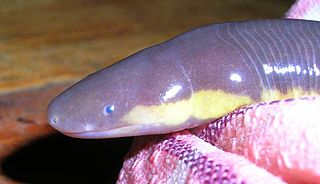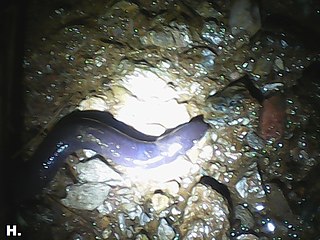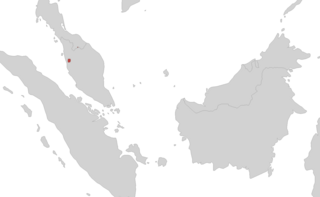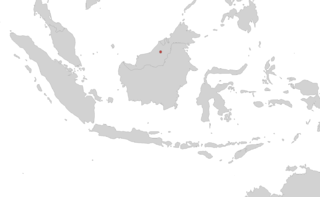
Caecilians are a group of limbless, vermiform (worm-shaped) or serpentine (snake-shaped) amphibians with small or sometimes nonexistent eyes. They mostly live hidden in soil or in streambeds, and this cryptic lifestyle renders caecilians among the least familiar amphibians. Modern caecilians live in the tropics of South and Central America, Africa, and southern Asia. Caecilians feed on small subterranean creatures such as earthworms. The body is cylindrical and often darkly coloured, and the skull is bullet-shaped and strongly built. Caecilian heads have several unique adaptations, including fused cranial and jaw bones, a two-part system of jaw muscles, and a chemosensory tentacle in front of the eye. The skin is slimy and bears ringlike markings or grooves and may contain scales.

The Ichthyophiidae are the family of Asiatic tailed caecilians or fish caecilians found in South and Southeast Asia as well as southernmost China.

Ichthyophis sikkimensis, the Sikkimese caecilian or Darjeeling caecilian, is a species of caecilian found in India, Nepal and possibly Bhutan. It was described by Edward Harrison Taylor in 1960.
Gegeneophis krishni, the Gurupur caecilian, is a species of caecilian found in India. It is only known from its type locality Gurupur, near Mangalore in Karnataka, India.

Ichthyophis orthoplicatus, also known as the Pattipola caecilian or brown caecilian, is a species of caecilian endemic to Sri Lanka. It is found in a range of natural and man-made habitats including evergreen forests, rubber and tea plantations, paddy fields, rural gardens and farms, wetlands, and cattle pastureland.

The Western Ghats in India are home to several species of caecilians (Gymnophiona). Caecilians are legless, burrowing amphibians which mostly live in leaf litter, loose soil, under rocks and decaying logs. They are also found in agricultural fields and only surface during the monsoon. The body is elongated and smooth with a slimy skin. The smaller caecilians superficially resemble earthworms while the larger ones are often mistaken for snakes. However, they can be told apart from earthworms by the presence of eyes, teeth and skeleton and from snakes by the lack of scales on skin. The eyes in caecilians are not well developed which is most likely to be because of their burrowing life style. They are considered as rare which is apparently due to their subterranean habits. To see them one has to search carefully and be at the right place and at the right time. There are few places where they are common, but, at least one species was reported to be abundant in agricultural fields in Kerala. The larger caecilians can resemble snakes, but their skin is smooth, not scaly.

Ichthyophis larutensis, the Larut Hills caecilian, is a species of amphibian in the family Ichthyophiidae found in Malaysia and Thailand. Its natural habitats are subtropical or tropical moist lowland forests, subtropical or tropical moist montane forests, rivers, intermittent rivers, plantations, rural gardens, heavily degraded former forest, irrigated land, and seasonally flooded agricultural land.

Ichthyophis billitonensis, the Billiton Island caecilian, is a species of amphibian in the family Ichthyophiidae endemic to the Belitung island, Indonesia. It was rediscovered in 2022 from Gunung Tajam, Belitung, after not having been recorded since the original description of the species in 1965. This appears to be a small species, measuring 135 mm (5.3 in) in total length. Habitat requirements are unknown but it probably inhabits moist lowland forests. It may be threatened by habitat loss caused by opencast tin mining.

Ichthyophis dulitensis is a species of caecilian in the family Ichthyophiidae. It is endemic to Borneo and only known from near its type locality, Mount Dulit in northern Sarawak, Malaysia, after which it is named. Described by Edward Harrison Taylor in 1960, the holotype was collected by Charles Hose already in 1891. It is a poorly known species with uncertain taxonomic status. Common name Mount Dulit caecilian has been coined for it.

Ichthyophis glutinosus, the Ceylon caecilian or common yellow-banded caecilian, is a species of caecilian in the family Ichthyophiidae endemic to Sri Lanka. Its natural habitats are moist tropical and subtropical forests and pastures.

Ichthyophis hypocyaneus, the Javan caecilian or marsh caecilian, is a species of amphibian in the family Ichthyophiidae of caecilians, endemic to Java, Indonesia. Until its rediscovery in 2000, it was known only from the 1827 type specimen.

The Koh Tao Island caecilian is a species of amphibian in the family Ichthyophiidae found in Cambodia, Laos, Myanmar, Thailand, and Vietnam. Also known as the Ichthyophis bannanicus, the Banna caecilian, it is also found in southern China.

Ichthyophis monochrous, the Western Borneo caecilian or black caecilian, is a species of amphibian in the family Ichthyophiidae. It is endemic to northern Borneo and known from western Kalimantan (Indonesia) and Sarawak (Malaysia), likely occurring also in Brunei. It is a little-known species known from only a few specimens. It presumably inhabits tropical moist forest. Adults are likely subterranean.

Hylarana garoensis, commonly known as Boulenger's Garo hill frog, Daniel's frog, Swift cascade frog, Garo's hill frog or the Mawphlang frog, is a accepted species of frog in the family Ranidae. H. garoensis' natural habitats are subtropical or tropical moist lowland forests, subtropical or tropical moist shrubland, subtropical or tropical high-altitude grassland, and rivers; it is found in India and possibly Bangladesh. It is threatened by habitat loss.
Gegeneophis is a genus of amphibians in the family Grandisoniidae. They are found in southern and northeastern India.
Ichthyophis daribokensis, or Daribok's striped caecilian, is a species of amphibian found in Assam in northern India.
Ichthyophis moustakius, the Manipur moustached caecilian, is a species of caecilian in the family Ichthyophiidae. It is endemic to Northeast India. This species exhibits broad lateral yellow stripes from the anterior part of its tail, along its mandibles, between its nares, as well as elsewhere. The animal can reach a length of 300 millimetres (12 in). Its head is somewhat U-shaped and fairly short; scales are absent on its collars. The species' name is derived from the Greek word moustakius, meaning "moustache", due to the yellow arched stripes it possesses.
Ichthyophis khumhzi, the Khumhzi striped ichthyophis, is a species of caecilian found in India. It has narrow and irregular lateral yellow stripes. It can attain lengths larger than 400 mm (16 in). Its head is V-shaped while short; the animal shows scales as far anterior as its collars. The species is named after Khumhzi village, where the specimens were first collected.
Ichthyophis sendenyu, the Sendenyu striped ichthyophis, is a species of caecilian found in India. This species of Ichthyophis possesses broad and solid lateral yellow stripes from about the level of the posterior of its disc to its eye level on the upper jaw, while arched yellow stripes extend to its nares. Its length does not exceed 350 millimetres (14 in). Its head is U-shaped and short. Scales are present in anteriormost grooves, with five to eight rows placed posteriorly on its dorsum. It is named after Sendenyu village, Nagaland, where the species was first found.














